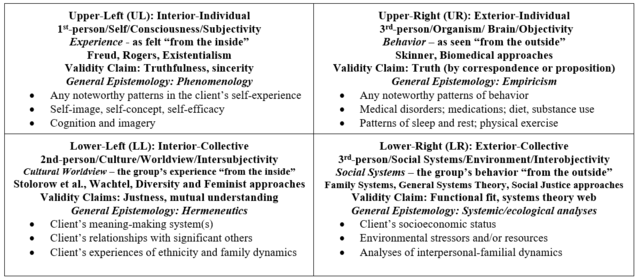Psychoanalysis
The Four Quadrants of Integral Metatheory
On the value of integrating multiple perspectives.
Posted October 8, 2020

Like other unification approaches, Integral psychotherapy emphasizes the importance of viewing and conceptualizing phenomena from multiple perspectives, rather than privileging one or two viewpoints. Integral Psychotherapy posits that what appears to be a plethora of contradictory perspectives can be coherently organized by a handful of unifying constructs. Due to space constraints, only the four quadrants will be discussed here. At the heart of Integral metatheory’s unifying perspective (Wilber, 2000) is the tenet that people can be viewed from four different perspectives: the inside of the individual (experiential/subjective/Upper-Left quadrant; UL), the outside of the individual (behavioral/objective/Upper-Right quadrant; UR), the inside of the collective (cultural/intersubjective/Lower-Left quadrant; LL), and the outside of the collective (social/interobjective/Lower-Right quadrant; LR) (See Figure 1).
Figure 1. A Very Brief Overview of the Four Quadrants of Integral Psychotherapy

In addition to the unique conceptual differences afforded by each quadratic perspective, I have also organized more than 200 therapeutic interventions by each quadrant (see chapter 6 of Marquis, 2018). Moreover, the quadrants reveal that diverse methodologies actually complement and enrich, rather than contradict, one another, thus promoting a deeper understanding of the subject at hand.
As shown in Figure 1, the quadrants reveal that each of the major epistemologies derive from examining phenomena from particular quadratic perspectives. Specifically, phenomenology adopts an interior-individual perspective, empiricism adopts an exterior-individual perspective, hermeneutics adopts an interior-collective perspective, and social systemic- and ecological-analyses adopt an exterior-collective view. Integral metatheory argues that any approach that systematically excludes any of the major methodological systems that appropriately elucidate pertinent dimensions of psychotherapy is dangerously narrow in scope. Inversely, the strongest validation of a theory or mode of practice would come from a convergence of observations from across the quadrants.
In contrast to the metaperspective offered by the four quadrants, many, if not most, psychotherapy approaches have tended to emphasize the perspective of only one of these quadrants in a way that was largely blind to insights offered by the others. For example, classical psychoanalysis and person-centered therapy emphasize the UL quadrant; behavioral and biomedical approaches emphasize the UR quadrant; feminist, diversity, and relational psychodynamics emphasize the LL perspective; and family systems and social justice approaches emphasize the LR perspective.
Integral metatheory posits that each of these approaches captures important truths about human nature, psychopathology, and treatment; yet each is only partially true because each fails to account for other important variables and dynamics that are disclosed only by considering other quadratic perspectives.
For example, research into neurotransmission (UR) cannot reveal the phenomenological experience (UL) of depression, and no amount of empathy or mutual understanding (LL) can disclose the neurological underpinnings of consciousness (UR). Likewise, behavioral analyses (UR) will not reveal the meanings of different cultural practices (LL) and no amount of intersubjective resonance (LL) will reveal the public policies or inequitable social arrangements (LR) that contribute to human suffering
The four quadrants increase and facilitate our appreciation of dialectics: They explicitly emphasize the imperative need to consider conclusions and principles that derive from historically opposing perspectives. Although dialectics have been described in many different ways, essential to them is the tension generated by simultaneously holding bipolarities in mind; it is this tension that often generates novel insights that are unlikely to emerge without deeply considering the dynamic interplay of what appear to be contradictory or oppositional elements. In this vein, although the empiricist-quantitative and hermeneutic-qualitative paradigms derive from opposed foundational assumptions regarding what constitutes legitimate knowledge, it is crucial to consider that the different perspectives and their associated methodologies only appear contradictory, incompatible, or incommensurable; it is more appropriate to view them as complementary and mutually enriching. In short, “both/and” thinking will advance and deepen our understandings of complex phenomena far more than “either/or” thinking.
Importantly, the very boundaries (such as interior/qualitative and exterior/quantitative; individual and collective) that divide therapists and researchers can also simultaneously connect them. Strict empirical methods will never disclose the qualities of lived-experience or what makes a life worth living, just as phenomenology will never reveal the neurobiological underpinnings of our experience. Is it not becoming increasingly clear that our understanding of human nature, psychopathology, and change processes will be augmented by a metatheoretical scaffolding that honors the validity of different perspectives and epistemologies, recognizes the limits of each, and provides a systematic way to organize them such that the different approaches synergistically complement, rather than contradict, one another?
Simply consider the differences between radical behaviorism and classical psychoanalysis. Their divergent conclusions are a predictable outcome of polar assumptions. Skinner (1953) posited that the only data worth studying are externally observable behaviors and environmental contingencies while Freud (1963) was primarily concerned not only with internal experience but largely unconscious determinants of that experience. Skinner privileged looking at that which was externally observable; Freud privileged “looking” from within. It is not that one of them was right and the other wrong. They were both partially correct and both incomplete (“true but partial”) because neither looked at the subject matter from more than one perspective.
How important do you think it is to conceptualize, practice, and perform research with the four quadrants in mind?
—Andre Marquis, Ph.D.
To find a therapist near you, visit the Psychology Today Therapy Directory.
Join the Convergence Special Interest Group listserv here for more information about the latest on convergence in psychotherapy.
References
Freud, S. (1963). An outline of psychoanalysis. New York: Norton.
Marquis, A. (2018). Integral psychotherapy: A unifying approach. New York, NY: Routledge.
Skinner, B. F. (1953). Science and human behavior. New York: Macmillan.
Wilber, K. (2000a). The collected works, Volume 6. Sex, ecology, sprirituality. Boston: Shambhala.




